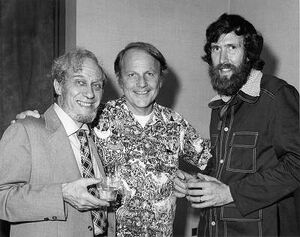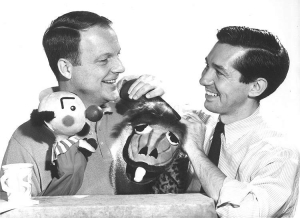No edit summary |
Pantalones (talk | contribs) m (→External Links) |
||
| Line 23: | Line 23: | ||
==External Links== |
==External Links== |
||
*[http://www.museum.tv/archives/etv/T/htmlT/tillstrombu/tillstrombu.htm Museum of Broadcast Communications -- Burr Tillstrom] |
*[http://www.museum.tv/archives/etv/T/htmlT/tillstrombu/tillstrombu.htm Museum of Broadcast Communications -- Burr Tillstrom] |
||
| − | *[ |
||
[[Category:References|Tillstrom]] |
[[Category:References|Tillstrom]] |
||
Revision as of 17:18, 23 May 2006
Template:Talk

Bil Baird, Burr Tillstrom, and Jim Henson at the National Puppetry Festival, circa 1973

Burr Tillstrom and Don Sahlin with Kukla and Ollie
Burr Tillstrom (1917-1985) was a puppeteer best known as the creator of the early television series Kukla, Fran, and Ollie. Tillstrom created his first puppet, a clown character who would be named Kukla following an encounter with a Russian ballerina, in 1936. His troupe of "Kuklapolitans" expanded in 1938 to include Oliver J. Dragon ("Ollie"). The group performed on early television broadcasts in 1939 and 1942. With the addition of Chicago actress Fran Allison in 1948, the program became known as Kukla, Fran, and Ollie, remaining on the air until 1954 and with several subsequent revivals. Tillstrom also performed on the satirical political series That Was the Week That Was, winning an Emmy for his Berlin Wall hand ballet.
On Kukla, Fran, and Ollie, Tillstrom developed the technique of watching the on-stage action through a small monitor as he performed the puppet characters. Jim Henson would adopt and expand this technique, which became a key component of Muppet performance. Don Sahlin had also worked as a builder for Tillstrom, rebuilding many of the Kuklapolitan characters for a Broadway show and other projects.
In 1960, Tillstrom met Jim and Jane Henson at a puppetry convention in Detroit. Through Tillstrom, Henson hired Don Sahlin. The Hensons also resided in Tillstrom's apartment building before moving to Greenwich in 1964. Tillstrom and Henson were both honored at the 1982 Detroit Institute of Arts convention.
Henson mentioned Tillstrom's work when he spoke at Edgar Bergen's funeral service in 1978: "I think of all these guys as part of puppetry... the frog here -- and Charlie and Mortimer -- Punch and Judy -- Kukla and Ollie. It's interesting to note that there have been puppets as long as we have had records of mankind."
Henson again discussed the influence of Tillstrom's work in a 1979 interview, as cited in Henson's own New York Times obituary: "Burr Tillstrom and the Bairds had more to do with the beginning of puppets on television than we did.. But they had developed their art and style to a certain extent before hitting television. Baird had done marionette shows long before he came to television. Burr Tillstrom's puppets were basically the standard hand-puppet characters that went back to Punch and Judy. But from the beginning, we worked watching a television monitor, which is very different from working in a puppet theater."
Tillstrom was inducted into the Television Academy Hall of Fame in 1986, the year after his death. Jim Henson offered a salute on the Hall of Fame broadcast on April 21st, though critic John J. O'Connor claimed it was "almost totally overshadowed by what looks like another episode of The Muppet Show." The Henson characters were also joined by Shari Lewis's Lamb Chop and Bil Baird's Charlemane for the salute. Fran Allison accepted the award for Tillstrom.
Cheryl Henson's book The Muppets Make Puppets included a brief biography and photo of Tillstrom in a section on famous puppeteers, alongside Jim Henson, Edgar Bergen, and Bil Baird.
References
- Bergen's funeral service quote from "Muppets In Movieland" by John Culhane, The New York Times Magazine, June 10, 1979.
- Tillstrom and television quote from Jim Henson's obituary by Eleanor Blau, The New York Times, May 17, 1990.
